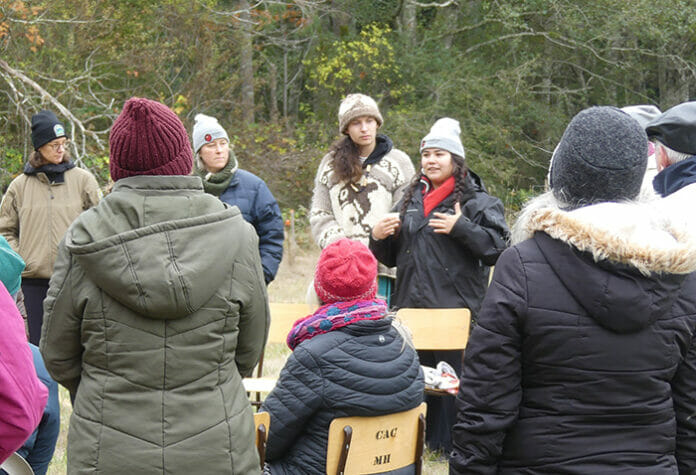Patience will be a crucial component of an ambitious wetland restoration and carbon sequestration project on Salt Spring Island — for both organizers and park users.
Over the next five years, some 20 hectares of field at Xwaaqw’um, also known as Burgoyne Bay Provincial Park, will be — slowly — transformed through restoration work, in partnership with Cowichan Tribes and BC Parks. The project is funded by Environment and Climate Change Canada through the Aboriginal Fund for Species at Risk Fund and Nature Smart Carbon Capture, and targets storing carbon naturally in forested areas — and improving habitat for the key species the Stqeeye’ Learning Society hopes to see thrive.
Critical to the restoration will be the planting of new native species wetland plants — and critical to their survival will be fencing to protect them from deer browsing. At a gathering of some 50 supporters and interested members of the public held at the restoration site Wednesday, Nov. 16, Stqeeye’ organizers laid out how the multi-year process would unfold.
“Part of what we wanted to do today is explain the physical changes there will be at the park, and address questions,” said biologist and project coordinator Rachel Bevington. “A lot of people access the park right here, there’s a well-worn path; we want everyone to know it’s Stqeeye’ putting up a fence, not someone you don’t know — and it’s not permanent.”
The project area is in the first open field on the left as you enter the park; organizers hope to see the return and recovery of several federally listed species at risk, including the western painted turtle, northern red-legged frog, western toad, dun skipper butterfly, and little brown myotis bat. Birders will be happy to learn several bird species will also benefit, including the peregrine falcon, band-tailed pigeon, barn owl, great blue heron, common nighthawk, western screech owl, black swift, horned grebe, Lewis’ woodpecker and the olive-sided flycatcher.
“We want to take the water that’s going out into the ocean, and sequester it back into the land and into the aquifers that we’re taking from,” said water data technician Tyee Joseph. “We can do that with wetlands. We’re going to be taking out a lot of the invasive grasses and replacing them with native plants.”
More wetlands mean more habitat, said Joseph, who highlighted the connection between the at-risk species and native plants with the example of the “green marble” butterfly.
“It lived in relation with the First Nations women that collected camas,” said Joseph. “Camas is a flower, and the bulb has a starch that was traded as far north as Alaska and as far south as Mexico — an economic staple of the First Nations people.”
The butterfly evolved alongside the flower and the people that harvested it, said Joseph. “So when there was a hole dug, the butterfly would actually go back into the hole and lay its larvae.”
Joseph said the butterfly had found one interesting way to adapt — just barely — at a shooting range on San Juan Island. Holes in an earthen backstop made by bullets there were close enough in size to those left behind from harvesting camas that some of the butterfly larvae laid in the holes survived.
Of course it wasn’t ideal, said Joseph, compared to the huge numbers that flourished alongside the camas in the past. “Hopefully we can actually collect camas in this area again,” he said.
Most of the valley bottom at Xwaaqw’um would have been “massive, towering red cedar” at one point, according to Bevington, with the associated plants, understory, wetlands and pools.
Native plants for the project are being grown with the help of Ken Eliot, a Cowichan elder partner and owner of a restoration nursery in Cowichan Bay. Stqeeye’ organizer Maiya Modeste said Eliot had jumped at the chance to be involved.
“When we got to show him all the wonderful things that were happening here, he kept saying ‘My prayers have been answered!’” said Modeste. “He said he’d been waiting for the next generation to get passionate about being on the land, and to have our future land stewards. ‘It’s finally here, and I can help!’”
Other funding partners include BC Parks, Indigenous Watershed Initiative, Habitat Conservation Trust Fund and community donors.
“An important takeaway is to remember that when we do a small thing today, it creates a better tomorrow for our future generations,” said Modeste. “It all ripples, and it all has a greater effect that maybe we can’t see today. But tomorrow it can be meaningful.”

